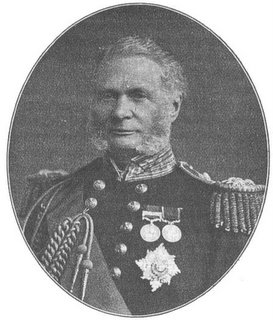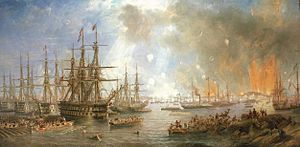Astley Cooper Key facts for kids
Quick facts for kids
Sir Astley Key
|
|
|---|---|

Sir Astley Cooper Key
|
|
| Born | 18 January 1821 London, England |
| Died | 3 March 1888 (aged 67) Maidenhead, Berkshire, England |
| Allegiance | United Kingdom |
| Service/ |
Royal Navy |
| Years of service | 1833–1886 |
| Rank | Admiral |
| Commands held | First Naval Lord North America and West Indies Station Royal Naval College, Greenwich HMS Sans Pareil HMS Amphion HMS Bulldog HMS Admiralty |
| Battles/wars | Anglo-French blockade of the Río de la Plata Crimean War Second Opium War |
| Awards | Knight Grand Cross of the Order of the Bath |
Sir Astley Cooper Key (born January 18, 1821 – died March 3, 1888) was a very important officer in the Royal Navy. He was known for his bravery in several wars.
As a young officer, he fought in the Battle of Vuelta de Obligado in 1845. He also took part in the Crimean War, including the Battle of Bomarsund and the Bombardment of Sveaborg. Later, he joined a special group of sailors called the Naval Brigade. With them, he fought in the Battle of Canton during the Second Opium War.
Sir Astley Key later led a special fleet of ships in the Baltic Sea. This fleet was formed in 1878 to stop Russia from entering Constantinople during a war. In 1879, he became the First Naval Lord, which is a very high position in the Navy. In this role, he focused on managing the Navy's money and making sure it had the best technology. He also made sure the Navy was ready for the Panjdeh Incident in 1885.

Astley Cooper Key was the son of Charles Aston Key, a famous surgeon. Astley joined the Royal Navy in August 1833 when he was just 12 years old. He first trained at the Royal Navy College in Portsmouth.
After his training, he served on ships in the Mediterranean Sea. From 1839, he was on HMS Cleopatra in North America and the West Indies.
He became a lieutenant in December 1842. He then served on HMS Curacoa in South America. In February 1844, he moved to HMS Gorgon. He was in charge of the small ship HMS Fanny during the Battle of Vuelta de Obligado in November 1845. This battle was part of a blockade by Britain and France.
In November 1845, he was promoted to commander. He then commanded HMS Bulldog in the Mediterranean. In October 1850, he became a captain. He took command of HMS Amphion in November 1853 and served in the Crimean War.
In May 1854, HMS Amphion and another ship, HMS Conflict, captured the town of Liepāja in Latvia. They did this without firing a single shot! He also fought in the Battle of Bomarsund in August 1854. And he was part of the Bombardment of Sveaborg in August 1855. For his service, he received an award called the Companion of the Order of the Bath.
In January 1856, Key took command of HMS Sans Pareil. This ship was stationed in the East Indies and China. He went ashore with a naval brigade to fight in the Battle of Canton in December 1857. This battle was part of the Second Opium War.
Later, in August 1859, he joined a special group called the Royal Commission on the Defence of the United Kingdom. This group advised on how to protect the country. In July 1860, he became captain of the steam reserve at Devonport. Then, in July 1863, he became captain of HMS Excellent and led the Royal Navy College at Portsmouth.

Astley Key played a big part in changing how the Navy was run. He was promoted to rear admiral in November 1866. He became the Director of Naval Ordnance, which meant he was in charge of naval weapons. He became an expert on muzzle-loading guns. Because of his knowledge, he was chosen as a Fellow of the Royal Society in June 1868. This is a very respected group of scientists.
In July 1869, he became the Admiral Superintendent of Portsmouth Dockyard. Then, in June 1870, he moved to Malta Dockyard. After that, he was the second-in-command in the Mediterranean.
Key was chosen to be the first President of the new Royal Naval College, Greenwich. He helped set up this important college, which opened the next year. He was promoted to vice admiral in April 1873. In May 1873, he was given another high award, the Knight Commander of the Order of the Bath.
In December 1875, he became the Commander-in-Chief of the North America and West Indies Station. In February 1878, he was asked to lead a special Baltic Fleet. This fleet was formed to stop Russia from entering Constantinople during the end of the Russo-Turkish War. He was promoted to full admiral in March 1878. In June 1879, he became a special aide to the Queen.
In August 1879, Key became the First Naval Lord. This was one of the most important jobs in the Navy. In November 1882, he received the highest award, the Knight Grand Cross of the Order of the Bath. As First Sea Lord, he focused on managing the Navy's money and making sure it had the latest technology. He made sure the Navy stayed within its budget. He also approved the building of six new battleships. He made sure the Navy was ready for the Panjdeh Incident in 1885. This was when Russian forces took land from Afghanistan.
In August 1884, he became a member of the Privy Council. This is a group of important advisors to the Queen. He retired in June 1885. Sir Astley Key passed away at his home in Maidenhead on March 3, 1888.
Family Life
Sir Astley Key married Charlotte Lavinia McNeil in April 1856 in Jersey. They had a daughter named Rose Champion de Crespigny, who became an artist and author. Sadly, Lady Charlotte passed away in December 1874.
In October 1877, Key married Evelyn Bartolucci in Halifax. She was the niece of the Governor of Bermuda, Major General John Lefroy.
Sources
- William Loney RN Career History
| Military offices | ||
|---|---|---|
| Preceded by Edward Fanshawe |
Admiral Superintendent, Malta Dockyard 1870–1872 |
Succeeded by Edward Inglefield |
| New office | President, Royal Naval College, Greenwich 1873–1875 |
Succeeded by Sir Edward Fanshawe |
| Preceded by Sir George Wellesley |
Commander-in-Chief, North America and West Indies Station 1875–1878 |
Succeeded by Sir Edward Inglefield |
| First Naval Lord 1879–1885 |
Succeeded by Sir Arthur Hood |
|
| Honorary titles | ||
| Preceded by Sir Henry Keppel |
First and Principal Naval Aide-de-Camp 1879–1886 |
Succeeded by Sir Geoffrey Hornby |

